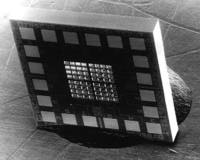1994 Project Reports | Contents | Previous | Next | Home |
The Nerve Chip: technology development for a chronic neural interface
Gregory TA Kovacs, MD, PhD; Vincent R Hentz, MD; Joseph M Rosen, MD
Objective - A chronic (permanently implanted) interface to the nervous system has long been sought. This work represents the development of integrated circuit fabrication technologies that may eventually make such interfaces possible. The goal is to provide a direct interface to peripheral nerves within an amputee's nerve stump and to derive electrical control signals suitable for controlling a limb prosthesis.
 Figure
1. Scanning electron micrograph of a 3 x 3 mm implantable device. The
array of via holes is visible at the center of the chip.
Figure
1. Scanning electron micrograph of a 3 x 3 mm implantable device. The
array of via holes is visible at the center of the chip.
Approach - The basic approach taken is to interpose a silicon substrate, perforated by a number of via holes, between the severed ends of a peripheral nerve. Regenerating axons grow through the via holes and thus become spatially fixed with respect to microelectrodes on the substrate. Such a neural interface, if chronically biocompatible, provides a direct interface to signal pathways in the nervous system.
Following consideration of designs of microelectrodes for such applications, the development of the required integrated circuit fabrication processes was undertaken. These fabrication methods were designed to be compatible with standard MOS and bipolar integrated circuit processes so that they could be combined to yield directly implantable, active devices.
Status - Feasibility of many of the basic concepts has been demonstrated. Preliminary results using passive (without on-chip transistors) regeneration-type neural interfaces indicated that recording from, and stimulation of, peripheral nerves in the rat is possible at durations of over one year. While the initial design of these devices was not refined for optimal nerve regeneration, it allowed the demonstration of the basic principle and the durability of devices fabricated with the process developed for this purpose.
An improved fabrication process was also demonstrated, designed for compatibility with industry-standard circuit processes, which provides a thin membrane for the via holes, surrounded by a thick silicon supporting rim. Biologically optimized devices were implanted and studied after nine months. Regeneration was verified histologically and it was observed that the regenerated nerves had reorganized into microfascicles containing both myelinated and unmyelinated axons and corresponding to the grid pattern of the via holes.
Consideration was also given to the development of active versions of these neural interfaces, which would contain on-chip signal processing circuitry. A non-implantable prototype device that was designed and fabricated served as a useful test vehicle for many of the basic design concepts. An implantable version is being fabricated and implants are planned this year.
Republished from the 1994 Rehabilitation R&D Center Progress Report. For
current information about this project, contact
Gregory Kovacs.